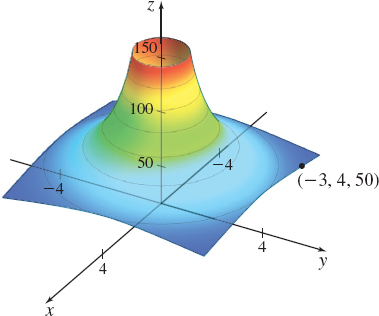EXAMPLE 5Modeling Temperature Change
A metal plate is placed on the xy-plane in such a way that the temperature T in degrees Celsius at any point P=(x,y) is inversely proportional to the distance of P from (0,0). Suppose the temperature of the plate at the point (−3,4) equals 50∘C.
- (a) Find T=T(x,y).
- (b) Find the gradient of T at the point (−3,4).
- (c) In what directions does the temperature increase most rapidly?
- (d) In what directions does the temperature decrease most rapidly?
- (e) In what directions is the rate of change of T at (−3,4) equal to 0?
869
Solution (a) The temperature T at any point (x,y) is inversely proportional to the distance of (x,y) from the origin (0,0). We can model T=T(x,y) as T(x,y)=k√x2+y2
where k is the constant of proportionality. Since T=50∘C when (x,y)=(−3,4), then k=T√x2+y2=50√(−3)2+42=50(5)=250
So, T=T(x,y)=250√x2+y2.

(b) The gradient of T=T(x,y)=250√x2+y2 is ∇T(x,y)=Tx(x,y)i+Ty(x,y)j=−250x(x2+y2)3/2i−250y(x2+y2)3/2j
At (−3,4), ∇T(−3,4)=−250(−3)[(−3)2+42]3/2i−250(4)[(−3)2+42]3/2j=750125i−1000125j=6i−8j
(c) The temperature increases most rapidly in the direction ∇T(−3,4)=6i−8j.
(d) The temperature decreases most rapidly in the direction −∇T(−3,4)=−6i+8j.
(e) The rate of change in T at (−3,4) equals 0 for directions orthogonal to ∇T(−3,4)=6i−8j. That is, the rate of change in T is 0 in either of the two directions orthogonal to 6i−8j, namely ±(8i+6j).